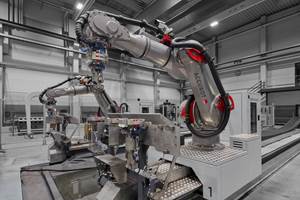Hexcel, A&P collaborate with NIAR to develop FAA certification framework for overbraided structures
Acceptable composite specifications, design data and methodology will enable affordable, high-rate structure manufacturing for DOD aircraft.
Serpentine inlet duct built under the MASC program, highlighted at CAMX 2025. Source | CW
Hexcel Corp. (Stamford, Conn., U.S.) is strategically collaborating with A&P Technology (Cincinnati, Ohio, U.S.) to work with the AFRL-funded Modeling for Affordable, Sustainable Components (MASC) research program and Wichita State University’s National Institute for Aviation Research (NIAR, Kan., U.S.) to develop a methodology for certification of overbraided structures using Hexcel’s IM7 24K fiber and 1078-1 resin system
“Our collaboration with A&P Technology represents a significant step forward in delivering critical airworthy composite preforms at high rate,” says Lyndon Smith, president, Americas and global fibers, Hexcel. “By combining our advanced fiber and resin technology with A&P Technology’s overbraiding expertise, we’re enabling the next generation of high-performance military and commercial aircraft structures.”
A&P Technology, a manufacturer of engineered braided reinforcements using its line of braiding machinery, has developed the capability to overbraid large-scale aircraft structures at high rate. Development of composite specifications, design data and a methodology for certification acceptable to the Federal Aviation Administration (FAA) will enable the adoption of this high-performance, low-cost, high-rate preform and part manufacturing by commercial airframe builders and will aid in its adoption into military platforms.
“Together, we are using feedback from specific aerospace primes to create preliminary design values for matrix systems, which will accelerate the process for full qualification and certification.”
Hawthorn Composites (Miamisburg, Ohio, U.S.) is currently producing inlet ducts for the Kratos XQ-58A Valkyrie using this overbraid and resin infused approach. Hawthorn has manufactured full-scale wings and fuselages for the same vehicle using similar approaches under the Design for Manufacture of Attritable Aircraft Primary Structure program (DMAAPS) program that culminated with a successful full-scale ground vehicle static test conducted by the AFRL. Independent analysis conducted by the AFRL concluded that use of braiding and overbraiding techniques on these types of parts would result in 57% cost savings when compared to hand applied prepreg and autoclave cure, and a 67% reduction in touch time.
“Net-shape braided preforms and overbraiding are both key technologies enabling the U.S. Department of Defense to realize their vision of affordable mass aircraft solutions,” notes Tom Margraf, CEO of Hawthorn Composites.
Overbraiding creates a controlled and predictable fiber change along the length of a part, including those with complex curvatures. Changing angles create mechanical property variation, but the controlled architecture allows for prediction of property change and creation of design envelopes.
The design of a composite combat drone inlet duct produced by NIAR, A&P Technology and Fiber Dynamics (Wichita, Kan., U.S.) will be used as the basis for the certification development. The complex curvature of the duct represents the types of aircraft structures that will require a path to FAA certification to take advantage of the high rate of manufacture benefits by overbraiding. A process is now in place that enables production of multiple duct preforms per shift, which opens a path to certification and adoption, according to officials from A&P Technology and NIAR.
“The overbraided serpentine inlet duct we developed under the MASC program is an excellent example of our partners’ capabilities and shows how modern braided composite technologies can advance aerospace innovation,” says Dr. Waruna Seneviratne, director of NIAR’s Advanced Technology Lab for Aerospace Systems (ATLAS). “Together, we are using feedback from specific aerospace primes to create preliminary design values for matrix systems, which will accelerate the process for full qualification and certification.”
“We’re excited to collaborate with Hexcel on this initiative,” says Andy Head, president of A&P Technology. “Our combined technologies offer a compelling solution for OEMs looking to quickly and consistently lay down fiber on complex load paths in complex geometries. This program will validate that the resulting structures are as easy to model and certify as incumbent, rate-limiting solutions.”
Related Content
Welding is not bonding
Discussion of the issues in our understanding of thermoplastic composite welded structures and certification of the latest materials and welding technologies for future airframes.
Read MoreDevelopment of a composite liquid hydrogen tank for commercial aircraft
Netherlands consortium advances cryogenic composites testing, tank designs and manufacturing including AFP, hybrid winding, welding of tank components and integrated SHM and H2 sensors for demonstrators in 2025.
Read More“Structured air” TPS safeguards composite structures
Powered by an 85% air/15% pure polyimide aerogel, Blueshift’s novel material system protects structures during transient thermal events from -200°C to beyond 2400°C for rockets, battery boxes and more.
Read MoreAutomated robotic NDT enhances capabilities for composites
Kineco Kaman Composites India uses a bespoke Fill Accubot ultrasonic testing system to boost inspection efficiency and productivity.
Read MoreRead Next
NIAR innovates overmolded TPC production process for eVTOLs
Fully automated hybrid thermoforming and injection overmolding process was executed to produce complex thermoplastic composite rib structure in 2 minutes versus 100-hour metal counterpart.
Read MoreHexcel, JetZero partner to qualify composites for BWB aircraft
This collaborative approach with Hexcel is accelerating the technological assessment and development of JetZero’s all-wing Z4 platform.
Read MoreFiber Dynamics, Fill GmbH partner to expand U.S. aerocomposites
The collaboration, supported by NIAR, will boost domestic production capabilities and global competitiveness.
Read More












